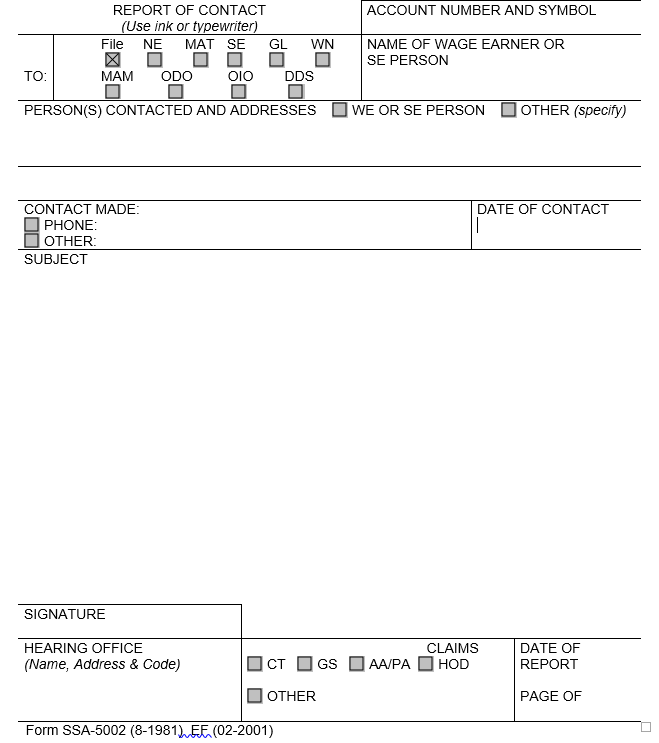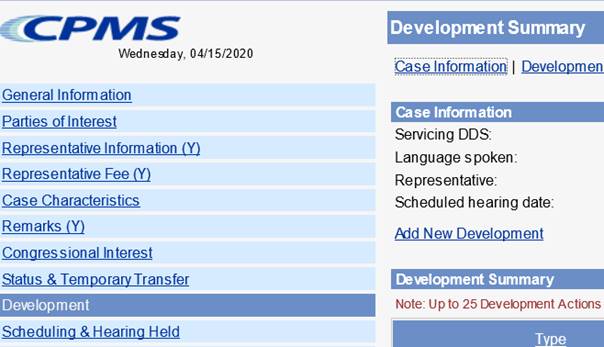COVID-19 Enhanced Outreach - Initial Call With Representative
Acknowledgement of Receipt (Notice of Hearing)
Guide for Initial Call and Encrypted Email Process for Represented Claimant Final
COVID-19 Enhanced Outreach - Initial Call With Representative
OMB: 0960-0671
Encrypted Email Process for COVID Enhanced Outreach (CEO) - Representative
Please follow these steps for sending the PDF file, and follow up phone call with the representative:
Decision writers (DW) will conduct initial outreach prior to the CEO on cases in Ready-to-Schedule (RTS) or Scheduled (SCHD) status for claimants whose representative does not have ERE access. We are prioritizing cases in SCHD status.
A Group Supervisor (GS) will add a case characteristic (CVEO) and assign a case to Unassigned ALJ Review – Pre Hearing (UNAP) status for the DW to complete a CEO. For cases in SCHD status, the GS will first put the case on SCHD HOLD before assigning the case to UNAP. For cases in RTS, the GS can assign the case to UNAP after the case characteristic has been added.
DW will find assigned cases by running a Workload Listing for cases in UNAP status in CPMS and check for a valid 1696 or other appointment of representation. For reference, the publicly available 1696 form is accessible on the Social Security website, at Claimant's Appointment of Representative. Other publicly available forms related to the disability process are available at https://www.ssa.gov/forms/.
DW will create a Report of Contact (ROC) via DGS by selecting Correspondence, then Other, then Report of Contact. The DW can then associate the ROC with the claimant’s SSN, select Done, and save the ROC to his or her folder on the shared drive. Use the ROC document whether contact was made, and, if successful, what transpired. Here is an example of a ROC generated using DGS:

4) DW will then check the Parties of Interest screen to see if an interpreter may be needed or if the claimant is a child. If the representative needs an interpreter, the DW should:
Contact the interpreter line at (1-800-200-7236) or (1-818-504-1296)
Tell the interpreter to hold, and then press the Conference soft key.
Then dial the claimant’s number, and after the claimant picks up, press the Conference soft key a second time.
Ask the interpreter to relay that you are calling the claimant from the Social Security Administration to gather some information about their claim for disability benefits.
DW should update the Parties of Interest languages section and the Scheduling & Hearing Held page of CPMS as applicable.
5) DW will then call the representative from his or her agency issued Softphone at the number on file and proceed as directed below.
If the DW is unable to reach the representative, the DW should leave a voicemail identifying himself or herself as set forth in the Introduction and Verification section below, and requesting that the representative, call back to discuss the claim as soon as possible.
DW should diary the case for 2 days, or sooner, as workloads demand, and call the claimant again at the end of the diary period.
If the DW is unable to reach the representative on the third attempt, the DW should deem the initial outreach and CEO unsuccessful, and follow steps in section 6 below.
Introduction and confirmation of representation
If contact is successful, the DW should say:
“Good morning/afternoon. My name is _________________ and I am [position title] with the [hearing office location] in the Social Security Administration.”
“May I speak with ___________________? Can you verify your name and address?”
[Ensure the information the representative provides matches the information that appears on the SSA-1696.]
[If no, politely end the call. If yes, proceed as follows:]
“Are you the representative for the claimant [Claimant Name]?”
[If the representative indicates that they do not represent the claimant, politely end the call. If the representative confirms that they represent the claimant, state the following:]
“As you may know, the coronavirus, or COVID-19, pandemic has required us to change our business process. I am calling you today to discuss those changes and assist you with obtaining a copy of your claimant's electronic file. Do you have a few minutes to talk?”
[If the representative is unavailable to speak at that time, set up a more convenient time to call back.]
B. Verify if Representative has ERE access.
“Mr./Ms. Representative, do you have access to the claimant’s electronic file?”
[If yes, you do not need to continue with obtaining the representative’s email address. Instead, set up a time to for the CEO.]
“I will call you back to answer any questions you may have about the file and the hearing. Are you available at XXam/pm?” (agree on day/time to call again.) Thank you for speaking with me."
[If the representative does not have ERE access:]
“To respond to the COVID-19 public health crisis, the Office of Hearings Operations (OHO) is closed to the public and temporarily conducting all hearings by telephone. Because our offices are also currently closed, we are currently unable to provide you with a CD containing the evidence in your claimant's file and you cannot visit one of our offices to review the evidence in person, as would normally be the case.”
C. Discuss emailing of evidence process.
“I would like to set up some time with you later today to discuss your options for a hearing and briefly review the record of evidence. Prior to the call, I would like to provide you with an electronic copy of the medical file. We are able to convert the medical evidence that is currently in an electronic folder to an encrypted Portable Document Format (PDF) and send to you via email. In order to do this, I will first need to obtain your email address. You are not required to provide an email address or receive your medical evidence by email. If you choose not to pursue this option, I will call back at a convenient time to discuss options for a hearing and other issues as well as briefly review the record of evidence.”
[If representative agrees to provide email address and receive folder electronically:]
"Thank you for your email address. I will email you a copy of your claimant’s file within a few minutes. It may take up to 30 minutes for you to receive your file. Please check your spam folder in case you do not see it. You will need a password to open your file which I will provide to you now. Please get a pen & paper to write your password down."
"Your password is _________."
[The following algorithm will be used to create the encryption password for media sent to representatives and/or claimants:
First four of claimant’s first name (lower case) as shown in CPMS and ARPS. If the name is less than four characters, use “#”s after the last alpha.
A number sign (#)
Last 4 numbers of the claimant’s SSN]
"I will give you some time to review the file. I will call you back to answer any questions you may have about the file and the hearing. Are you available at XXam/pm?” (agree on day/time to call again.) Thank you for speaking with me."
[If the representative refuses or does not have an email address or device to view file:]
"Thank you for your time. We will call you again to review your file with you over the phone before your hearing, and explain what to expect at the hearing."
6) After the phone call, DW should use the below guide to create an encrypted copy of the eview exhibit list and exhibited documents in .pdf format to send to the representative.

DW should create a Development in CPMS assigned to the supervisor, to communicate necessary development as indicated in the ROC. If the DW is unable to connect with claimant after multiple attempts, DW should create a Development in CPMS to communicate that attempts to contact the claimant were made and were unsuccessful.
To create a Development item:
In CPMS Development screen, select Add New Development

![]()
Development group: Other
Type: Unsolicited Development
Place development in your supervisor’s name

Select the radial button that states Request has not been sent, click Save

DW should add the appropriate case characteristic (CVNC).
DW should copy/paste the completed ROC Template into the ROC in the SUBJECT section, then send to eView by selecting the ADD-INS button, then Send to eFolder, then SEND.
If contact was unsuccessful, use the following ROC format:
I did not reach the representative for a COVID Enhanced Outreach.
Provide reason(s) for unsuccessful attempt:
Confirm if voicemail(s) left:
Call(s) attempted on (Date(s)):
If contact was successful, use the following ROC format:
I reached the claimant to discuss emailing the electronic file on the date of this ROC.
During the CEO:
Verified the representative’s contact information
[If applicable] Obtained the representative’s email address and send an encrypted copy of the electronic file to the claimant.
Representative’s email address is: (enter representative’s email address)
Follow up call to conduct CEO scheduled for: (enter date/time)
| File Type | application/vnd.openxmlformats-officedocument.wordprocessingml.document |
| Author | Agarwal, Renu |
| File Modified | 0000-00-00 |
| File Created | 2021-01-13 |
© 2026 OMB.report | Privacy Policy